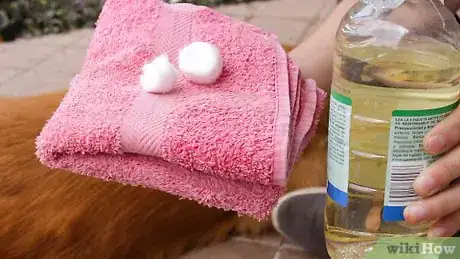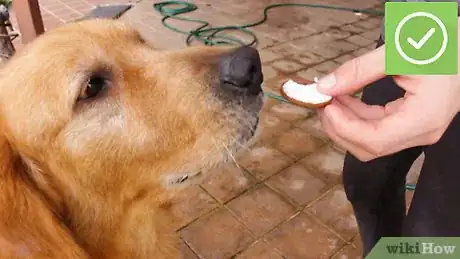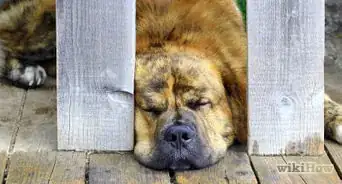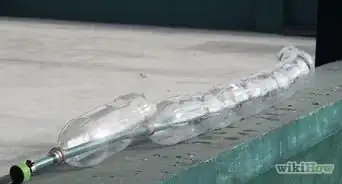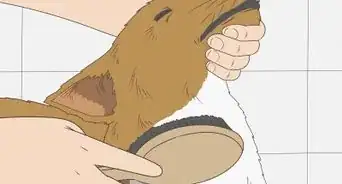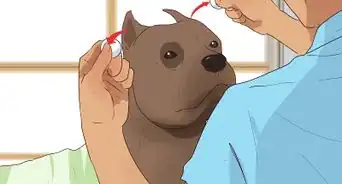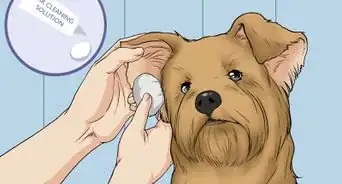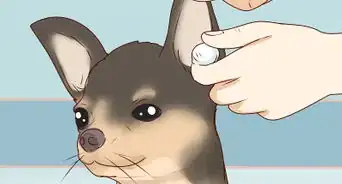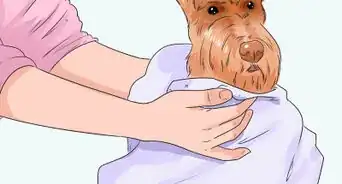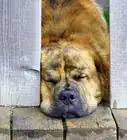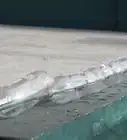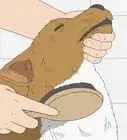This article was co-authored by Marie Lin. Marie Lin is a Licensed Pet Groomer and the Owner of Marie's Pet Grooming, a grooming salon based in New York City. Marie has over 10 years of pet grooming experience specializing in dogs and cats. She earned her pet grooming certification from the American Academy of Pet Grooming New York in 2009 and is also a member of the National Dog Groomers Association of America. She earned a Master of Business Administration (MBA) from Hawaii Pacific University in 2007.
There are 18 references cited in this article, which can be found at the bottom of the page.
wikiHow marks an article as reader-approved once it receives enough positive feedback. This article received 15 testimonials and 97% of readers who voted found it helpful, earning it our reader-approved status.
This article has been viewed 722,006 times.
How often you need to wash your dog depends on a variety of things, including the dog’s breed, size, type of coat, and activities. Dogs that are frequently outdoors may need more frequent baths, while indoor dogs may need a bath only every few months. Baths can be scary for dogs, but with a little knowledge and preparation, you can make washing your dog a good experience for both of you.
Steps
Preparing to Wash Your Dog
-
1Choose a location. If you have a very small dog, you can bathe him in a laundry or kitchen sink. You can bathe larger dogs in showers or bathtubs. If it’s not too cold outside, you can even bathe your dog outside.
- If you bathe your dog in a bathtub or sink, the bottom will get slippery when it’s wet. To help calm your dog and give him traction, put a towel on the bottom of the tub or sink. You can also use a rubber bath mat or nonslip adhesive pads.[1]
- Choose a confined location, if possible. Your dog may get anxious or upset during his bath and try to escape. Shut the bathroom door if you use the bathtub. If you’re washing your dog outside, make sure to do it in a fenced area so your dog can’t run away.[2]
-
2Prep your dog for washing. Brush your dog’s fur thoroughly before giving him a bath. This is especially important if your dog has a thick, shaggy, or double coat. Make sure to remove any tangles or matted areas.
- If your dog has any ticks, you may want to see a vet to get them removed. Or you can remove it yourself.
- If your dog has sticky substances (e.g., paint, tar, pine sap) stuck in his fur, rub them with petroleum jelly or vegetable oil and let it sit for 24 hours. A liquid dish soap may also do the trick.
EXPERT TIPMarie Lin is a Licensed Pet Groomer and the Owner of Marie's Pet Grooming, a grooming salon based in New York City. Marie has over 10 years of pet grooming experience specializing in dogs and cats. She earned her pet grooming certification from the American Academy of Pet Grooming New York in 2009 and is also a member of the National Dog Groomers Association of America. She earned a Master of Business Administration (MBA) from Hawaii Pacific University in 2007.Licensed Pet Groomer
 Marie Lin
Marie Lin
Licensed Pet GroomerOur Expert Agrees: Before you wash your dog, brush their fur out and try to remove any knots and tangles. Also, put cotton balls in the dog's ears to prevent water from getting in, especially if their ears point straight up.
Advertisement -
3Trim your dog’s nails. If your dog’s nails need trimming, trim them before you give him a bath. This will help keep him from accidentally scratching you if he gets agitated or fussy. [3]
Do not cut your dog’s nails too short! You can easily cut into the dog’s quick, which can cause bleeding and infection. If you aren’t sure how to trim your dog’s nails, many groomers and veterinarians will do it for a small fee.
-
4Gather all the supplies you’ll need. Once you start the washing process, you’ll want to have everything you need close to hand. You will need towels, cotton balls, dog shampoo, treats, and a washcloth or sponge. If you don’t have a hose or detachable showerhead, you will need a bucket or other vessel for rinsing.
- Uncap your shampoos and other bottles so that you don’t have to do that while keeping a wet dog in check.
- If your dog tends to be nervous in the bath, you may want to have a helper. The helper can help keep your dog steady while you wash him.
-
5Put cotton balls in your dog’s ears. When dogs’ ears get wet, they can develop ear infections. Putting cotton balls in his ears will help keep the ear canals dry.[4]
Don’t push the cotton balls too far down. Just secure them enough so they don’t fall out in the bath.
-
6Remove your dog’s collar. To get his neck area clean, you will need to remove the dog’s collar. If you need a collar to keep hold of your dog while bathing him, use a nylon collar. Leather collars can shrink when wet, and could choke your dog.
Bathing Your Dog
-
1Get the temperature right. Dogs are sensitive to hot water just like you are. Check the water temperature before you bathe your dog. It should be warm, but not hot. Water that’s too cold can give your dog a chill, which is especially dangerous for puppies.
- If you’re bathing in a sink or tub, fill it to about your dog’s knees with warm water.
-
2Wet your dog’s body with water. It’s not recommended that you wash your dog’s head or face. This can end up getting water in his ears or stinging his eyes with shampoo. Instead, wet him from the neck back. Make sure his coat is fully saturated. This can take awhile for dogs with especially thick coats.
- If you have a hose or detachable showerhead, use it to spray your dog. Make sure the water pressure isn’t too high, or it could startle him.
- If you use a bucket or pitcher to wet your dog, make sure to avoid pouring water over his head.[5]
- There are also snap-on sprayer attachments that attach to your showerhead or faucet. The ASPCA recommends the Rinse Ace Pet Shower Deluxe.[6]
-
3Apply the shampoo. If your dog’s coat is very thick or long, you may want to pre-mix some shampoo with water in a small cup. This will help you get an even lather throughout his coat. For dogs with short coats, just pour a strip of shampoo down the body. Massage the shampoo into his coat.
- You do not need to use a washcloth or sponge to apply the shampoo. In fact, it’s a better idea to use your hands as you lather up the shampoo. This way, you can check his body for any unusual signs, such as bumps or inflammation.[7]
- Do not apply shampoo to your dog’s head or face. If his face is dirty, use a damp washcloth to gently wipe away any dirt.[8]
- If your dog has a very long coat, massage the shampoo in the direction of his hair growth. This will help prevent tangling.
-
4Wash the dog’s body. Massage the shampoo onto the whole body except for the head. Lather up his armpits, stomach, tail and groin area, and paws, too.
- Keep the shampoo on your dog for as long as the bottle calls for. Some shampoos contain mild flea repellents, and they may need to stay on for a certain amount of time to be effective.
-
5Clean your dog’s face. If your dog’s face is dirty, use a damp washcloth to wipe the dirt away. Don’t clean inside his ears with a washcloth; this can get the ears too wet and promote infection.
- Some dogs have a skin infection on their chins called furunculosis, which looks like small pimples or red bumps. If your dog has this condition, you should consult with your vet to see how to properly clean the area. Your vet may suggest a disinfecting shampoo or ointment.
- If your dog has folds in his facial skin, make sure to use the washcloth to clean in between them.
-
6Rinse your dog until the water from his fur runs clear. It’s important to rinse all of the shampoo residue from your dog’s coat. This can take awhile to do thoroughly, especially when your dog’s fur is thick or double-coated.[9] Not rinsing your dog’s coat properly can lead to skin irritation and pH imbalance.
- Remember not to pour water over your dog’s head and face. If you’re using a pitcher or bucket to rinse, pour water so that it flows down his back, not toward his face. Avoid spraying your dog’s face if you’re using a hose or sprayer.[10]
-
7Dry your dog. If you can find a highly absorbent microfiber towel, it will make the drying process quicker; however, even a regular bath towel will work.[11] Lay the towel over your dog's back and pat him dry. Don’t rub the towel, as this can cause matting in long-haired breeds. Remember that your dog’s natural instinct will be to shake himself dry, so be prepared for some splattering.[12]
- Some people may use hair dryers to dry their dog’s fur. Keep the heat setting on low or cool to avoid burning your dog. Never point a hair dryer at your dog’s face.#Comb out your dog’s coat. If your dog has very long or shaggy fur, you will want to comb it out while it’s wet to avoid it tangling. You can use a detangling mist to help this process.
- Some people may use hair dryers to dry their dog’s fur. Keep the heat setting on low or cool to avoid burning your dog. Never point a hair dryer at your dog’s face.#Comb out your dog’s coat. If your dog has very long or shaggy fur, you will want to comb it out while it’s wet to avoid it tangling. You can use a detangling mist to help this process.
-
8Give your dog a treat. To keep the positive associations with bathtime strong, give your dog a treat every time you wash him. Praise him for being a good dog. This way, your dog will learn that bathtime is not a time to dread but a fun time that involves treats and praise.[13]
If your dog is particularly nervous during baths, you may even give them a little treat during the washing process.
Grooming Your Dog After a Wash
-
1Clean your dog’s ears. Remove the cotton balls from your dog’s ears. You should clean his ears of excessive earwax to help avoid irritation or infection. You can use a specially formulated ear rinse such as Vetericyn Ear Rinse. You can also use witch hazel, hydrogen peroxide, or a mixture of equal parts organic apple cider vinegar and purified water.
- Apply some of the ear cleaner on a cotton ball. Do not use cotton swabs. You could damage your dog’s eardrums if you insert them too far.
- Rub the cotton ball around the inside of the ear. Check the cotton ball for waxy residue. Once you don’t see any more residue on the cotton ball, your dog’s ears are clean. You can also use a soaked cotton ball to clean the dog’s outer ears (the large flappy bits are called the pinna).
- Try not to pour or spray the solution directly into the dog’s ears. Many dogs don’t like this, and you want to avoid as many negative associations with bathtime as possible.
- If your dog has hairs growing from his ear canal, consult your vet. Some breeds can develop tangled ear hair, which can lead to ear infections.[14]
-
2Clean off tear buildup. Some dogs have a condition called epiphora, which occurs when your dog’s tears overflow onto his face.[15] This is very common in brachycephalic breeds such as many terriers and chihuahuas.
- Colloidal silver is commonly recommended, as it is safe to use around the eyes. It comes in spray or liquid drops form. Apply colloidal silver to a clean cotton ball and wipe your pet’s eyes.
- Dabbing a bit of coconut oil beneath the eyes where the tear stain “tracks” are can help keep the skin from getting irritated.
- Many pet supply stores sell tear stain cleansers and even pre-saturated pads. These can be easy to use. Just make sure that the product is marked hypoallergenic and that it doesn’t contain the substance tylosin tartrate. This antibiotic is not approved for use on dogs or cats.
- Some breeds, such as poodles and shih-tzus, have a condition called distichiasis, where their eyelashes grow inward rather than outward. This can cause eye irritation and excessive tearing. If you notice that your dog has frequent tear buildup, consult with your vet. It may be nothing more than a result of his facial shape, but it is always better to be safe.[16]
- Do not use hydrogen peroxide, apple cider vinegar, makeup remover, human eye drops, or milk of magnesia to clean your dog’s eyes.
-
3Give your dog another treat. Now that he’s all clean, give your dog another treat. Praise him for being a good dog. Give him some petting and perhaps play a game.[17]
Understanding Good Bathing Habits
-
1Avoid washing your dog too often. There is usually no reason to bathe a dog unless he has a skin infection or he smells bad. You can usually bathe your dog once a month to keep him smelling pleasant.[18] If you bathe him more than that, you can cause skin irritation and he may scratch a lot.[19]
- Brush your dog’s coat often. This will help keep him clean in between baths, and it’s also good for his skin and coat.
- If your dog has a skin infection, consult with your vet to see how best to wash and treat your dog.
-
2Choose the right shampoo. A mild shampoo formulated for dogs is the best idea. Look for a shampoo that has a neutral pH balance, around 7. Avoid artificial fragrances and colors, as these can also irritate your dog’s skin.[20]
- You should never use human shampoo to wash your dog. Dogs’ skin has a different pH balance than human skin, and human shampoo can disrupt that balance. Disrupted pH balance can foster bacteria, parasites, and viruses.[21]
- Oatmeal shampoo is a good basic choice for most dogs. If you're not sure what to use, it's a safe shampoo to start with.
- If your dog has a skin rash or other condition, he will often scratch, which will further irritate his skin. Tea tree shampoo can be helpful for some skin irritations. Avoid getting the shampoo into his mouth, as tea tree oil is toxic when consumed. Consult with your vet to determine what shampoo to use for a dog with skin conditions.
- Some shampoos can help prevent flea infestations. Look for shampoos containing pyrethrin, pyrethrum, or citrus oil.
-
3Leave your dog’s anal sacs alone unless you know how to express them safely. Your dog has small sacs on his back end, at the edge of his anus. Some dog groomers offer to “express,” or squeeze, the anal sacs during cleaning. If your vet approves and you know how to do it safely, it's okay to try doing so at this point. Otherwise, leave them alone.
- If your dog has inflamed or irritated anal sacs, consult your vet.[22]
-
4Accustom your dog to the bath. If your dog is new to your home, he may be afraid of bathtime. You can help him learn to associate baths with positive experiences with a few simple tricks.[23]
- If your dog is terrified of the bath, place your dog in an empty tub (or wherever you wash your dog). Don’t run water yet. Speak to him in a soothing voice and give him a treat or toy to play with. This will help him associate bathtime with something he enjoys.[24]
- Work your way up to running warm water over his body. Every time you bathe your dog, give him/her a little treat.
- Get your puppy used to the bath by washing him after he is five weeks old. Getting your puppy used to bathtime as a pleasant experience will make it easier for him to accept baths when he’s older.[25]
Expert Q&A
Did you know you can get expert answers for this article?
Unlock expert answers by supporting wikiHow
-
QuestionCan I wash my dog after his meal?
 Pippa Elliott, MRCVSDr. Elliott, BVMS, MRCVS is a veterinarian with over 30 years of experience in veterinary surgery and companion animal practice. She graduated from the University of Glasgow in 1987 with a degree in veterinary medicine and surgery. She has worked at the same animal clinic in her hometown for over 20 years.
Pippa Elliott, MRCVSDr. Elliott, BVMS, MRCVS is a veterinarian with over 30 years of experience in veterinary surgery and companion animal practice. She graduated from the University of Glasgow in 1987 with a degree in veterinary medicine and surgery. She has worked at the same animal clinic in her hometown for over 20 years.
Veterinarian
-
QuestionHow do I get rid of fleas?
 Pippa Elliott, MRCVSDr. Elliott, BVMS, MRCVS is a veterinarian with over 30 years of experience in veterinary surgery and companion animal practice. She graduated from the University of Glasgow in 1987 with a degree in veterinary medicine and surgery. She has worked at the same animal clinic in her hometown for over 20 years.
Pippa Elliott, MRCVSDr. Elliott, BVMS, MRCVS is a veterinarian with over 30 years of experience in veterinary surgery and companion animal practice. She graduated from the University of Glasgow in 1987 with a degree in veterinary medicine and surgery. She has worked at the same animal clinic in her hometown for over 20 years.
Veterinarian Bathing is not a great strategy as the fleas only hop on the dog to feed, which means although some will drown during the washing, most live on in the dog's bedding or the soft furnishings. You are best advised to use one of the many excellent prescription products that kill fleas, and if the infestation is severe, use a product to kill flea larvae in the environment.
Bathing is not a great strategy as the fleas only hop on the dog to feed, which means although some will drown during the washing, most live on in the dog's bedding or the soft furnishings. You are best advised to use one of the many excellent prescription products that kill fleas, and if the infestation is severe, use a product to kill flea larvae in the environment. -
QuestionIt's difficult to wash my Maltese dog's beard and snout. How can I approach this?
 Community AnswerYou can use a toothbrush with some dog shampoo on it. Make sure to stay clear of the dog's eyes, mouth, and nostrils.
Community AnswerYou can use a toothbrush with some dog shampoo on it. Make sure to stay clear of the dog's eyes, mouth, and nostrils.
Warnings
- If your dog develops a rash, or any other sign of an allergic reaction, contact your veterinarian immediately.⧼thumbs_response⧽
- Do not dye your dog’s hair. It can cause serious health problems.⧼thumbs_response⧽
Things You'll Need
- A bathtub or sink (if the dog is small)
- Towel
- Pet Shampoo
- Water
- Sponge or washcloth
- Bucket or pitcher, or a detachable showerhead or sprayer
- Cotton balls
- Dog brush/comb
- Treats
References
- ↑ https://www.aspca.org/pet-care/virtual-pet-behaviorist/dog-behavior/bathing-your-dog
- ↑ https://www.aspca.org/pet-care/virtual-pet-behaviorist/dog-behavior/trimming-your-dogs-nails
- ↑ https://www.aspca.org/pet-care/virtual-pet-behaviorist/dog-behavior/trimming-your-dogs-nails
- ↑ https://www.cesarsway.com/how-to-bathe-your-dog/
- ↑ https://www.aspca.org/pet-care/virtual-pet-behaviorist/dog-behavior/bathing-your-dog
- ↑ https://www.aspca.org/pet-care/virtual-pet-behaviorist/dog-behavior/bathing-your-dog
- ↑ https://www.aspca.org/pet-care/virtual-pet-behaviorist/dog-behavior/bathing-your-dog
- ↑ https://www.aspca.org/pet-care/virtual-pet-behaviorist/dog-behavior/bathing-your-dog
- ↑ https://www.aspca.org/pet-care/virtual-pet-behaviorist/dog-behavior/bathing-your-dog
- ↑ https://www.cesarsway.com/how-to-bathe-your-dog/
- ↑ https://www.cesarsway.com/how-to-bathe-your-dog/
- ↑ https://www.cesarsway.com/how-to-bathe-your-dog/
- ↑ http://www.petshed.com/petcyclopedia/how-to-wash-dog-properly.html
- ↑ https://www.aspca.org/pet-care/dog-care/ear-care
- ↑ https://www.cesarsway.com/tear-staining-causes-and-treatment/
- ↑ https://www.cesarsway.com/tear-staining-causes-and-treatment/
- ↑ https://www.aspca.org/pet-care/virtual-pet-behaviorist/dog-behavior/bathing-your-dog
- ↑ https://www.cesarsway.com/how-often-to-bathe-a-dog/
- ↑ https://www.aspca.org/pet-care/virtual-pet-behaviorist/dog-behavior/bathing-your-dog
- ↑ http://www.petmd.com/dog/grooming/evr_dg_shampoo_for_dogs
- ↑ http://www.petmd.com/dog/grooming/evr_dg_shampoo_for_dogs
- ↑ http://www.petmd.com/dog/general-health/evr_dg_anal_sac_problems
- ↑ https://www.cesarsway.com/how-to-bathe-your-dog/
- ↑ https://www.aspca.org/pet-care/virtual-pet-behaviorist/dog-behavior/bathing-your-dog
- ↑ https://www.aspca.org/pet-care/virtual-pet-behaviorist/dog-behavior/bathing-your-dog
- Videos provided by PetCareRxVideo
About This Article
Before you bathe your dog, brush its fur thoroughly, place cotton balls in your dog's ear canal to protect it from getting an ear infection. Adjust the temperature of the water so it's warm but not hot. Wet your dog from its neck to its tail, making sure you fully saturate the coat. Then, pour a strip of shampoo down your dog's back and massage it in. Lather your dog's entire body except for its head. Use a washcloth to gently clean your dog's face. Rinse your dog completely, and pat it with a towel to dry. Keep reading for more tips from our Veterinary co-author, including how to trim your dog's nails before a bath!


